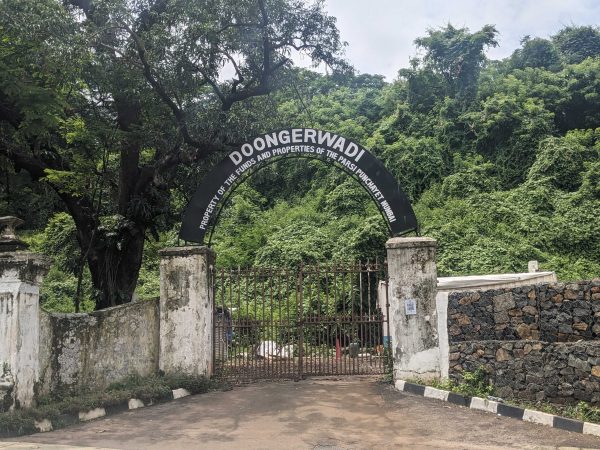Situated right near downtown Mumbai, India is an area of about 55 acres of dense, overgrown forest. In one of the most populous cities in the world, this is a place where peacocks roam freely — a space out of time. This forest is protected by a religious community. It has survived in a relatively undeveloped state in the middle of this gargantuan city. Importantly, it’s also home to an ancient tradition that’s in crisis — one that is central to the lives (and deaths) of a particular population.
There’s a certain point in this forest beyond which almost no one can step — only special caretakers of these grounds can go any further. They go by many names: khandia, nassassalar, pallbearer, corpse bearer. Their work here is holy. They carry dead bodies to their final resting place – atop stone structures that stand gray against the lush green. These buildings are called Towers of Silence.
 The Towers of Silence are part of a death ritual carried out by Parsis, a small but prosperous community in India. Parsis practice Zoroastrianism, a monotheistic religion originally from Iran. Zoroastrians in Iran were persecuted in the 7th century during the rise of the Islamic Empire, and Muslim armies gave surviving Zoroastrians a choice: conversion or exile. Eventually, a small group of Zoroastrians fled Iran for the shores of Western India, bringing with them any surviving fragments of tradition.
The Towers of Silence are part of a death ritual carried out by Parsis, a small but prosperous community in India. Parsis practice Zoroastrianism, a monotheistic religion originally from Iran. Zoroastrians in Iran were persecuted in the 7th century during the rise of the Islamic Empire, and Muslim armies gave surviving Zoroastrians a choice: conversion or exile. Eventually, a small group of Zoroastrians fled Iran for the shores of Western India, bringing with them any surviving fragments of tradition.
Zoroastrians who settled all over India came to be known as Parsis. Eventually, in the 1600s, Mumbai became their epicenter. This was back when this city was still a collection of swampy, mosquito-infested islands, seemingly far enough away from the civilized world. A few wealthy Parsis bought a vast expanse of land here, and they gave it to the community for one specific purpose.
The Towers of Silence are where Parsis place their dead. And, despite its imposing gothic-era name that’s used by Parsis and non-Parsis alike, Towers of Silence aren’t actually all that towering at all. These structures got that name by the British who wanted an English term to describe them. And in doing so, they made them sound perhaps a bit more grandiose than they actually are.
These Towers, also known simply as dakhmas, are built of stone, usually up to 50 feet tall and up to about 100 feet wide. Imagine something more like an open-aired amphitheater; each Tower is circular and roofless. There are markers indicating where bodies should be placed. And in the very center, there’s a deep well – storage for the bones of Parsi bodies. Wherever large clusters of Parsis settled, they would cultivate forests, or Doongerwadis, and build dakhmas inside them. Five dakhmas were built here in Mumbai which in total are able to handle over a thousand corpses a year.
 Zoroastrians have practiced this ritual of sky burial in Mumbai for centuries. According to the faith, as soon as we die, our bodies become contaminated with evil. And this evil must not, under any circumstance, make contact with the sacred elements of fire, water, and earth. Instead, the corpse bearers will place the body atop one of these Towers. Then, they will wait for the vultures to come.
Zoroastrians have practiced this ritual of sky burial in Mumbai for centuries. According to the faith, as soon as we die, our bodies become contaminated with evil. And this evil must not, under any circumstance, make contact with the sacred elements of fire, water, and earth. Instead, the corpse bearers will place the body atop one of these Towers. Then, they will wait for the vultures to come.
Circling Overhead
According to some estimates there were once at least around 40 million vultures throughout India. But no one will ever really know an exact number. They were so plentiful, in fact, that no scientific efforts were ever made to do a population count. India’s civil aviation department would even hire people to shoot vultures around airports because they posed such a hazard to air traffic. In the sky, vultures loom large, casting shadows with 8-foot wingspans. And on the ground, sometimes you can only see their bodies, their bald heads often buried deep inside a fresh carcass.
And yet for centuries, a very specific symbiosis played out here in Mumbai, between these vultures, this forest, and the Parsis. Time passed, wars came and went, cities grew, trees fell. But this practice survived. In Mumbai, approximately three new bodies were carried up every day. It was an efficient send-off, one in which your body became your final offering to the natural world. Most of all, it was tradition.
But this tradition would begin to unravel.
A Seamless Cycle for Centuries
Parsis practiced this system of placing deceased loved ones atop these Towers — a practice called dokhmenashini — for centuries. It was a seamless cycle of life and death, passed on from one generation to the next. But in the 1980s, one thing in this cycle changed, and then everything started to topple. In the early 1980s, fewer and fewer vultures could be seen sitting and waiting at their usual perch — soon after, it seemed like all the vultures had disappeared altogether.
Khandias would carry a few new bodies into the Towers, only to find that yesterday’s bodies were still untouched by vultures. The vulture deaths were felt outside the Parsi community too. Vultures have scoured the countryside, cleaning up dead cattle for all of human history. So eventually, more people across the country began to notice their absence.
 Scientists ran through theories from food shortage to habitat loss. They looked into the possibility of contagious disease. But nothing was conclusive. Then finally, in 2003, they made a shocking discovery. The vultures had been dying of kidney failure. And the culprit was a prescription painkiller, similar to Ibuprofen and Aspirin, called Diclofenac.
Scientists ran through theories from food shortage to habitat loss. They looked into the possibility of contagious disease. But nothing was conclusive. Then finally, in 2003, they made a shocking discovery. The vultures had been dying of kidney failure. And the culprit was a prescription painkiller, similar to Ibuprofen and Aspirin, called Diclofenac.
Overdosed
Diclofenac is a cheap drug that was first introduced in the 1970s for the treatment of arthritis and pain management in humans. By the early 1990s, Diclofenac became a veterinary painkiller. And because of its recently expired patent, it ended up being the cheapest and most popular livestock drug on the market. Hinduism’s reverence for cows means that in India, most cattle are left to die naturally in the fields, where vultures would reliably finish the job. Farmers would give Diclofenac to cows. And when those cows died with Diclofenac in their system, vultures would eat them and get poisoned by the drug. Because India has the largest cattle population in the world, this was happening at an enormous scale. Soon, the vulture deaths became a national crisis.
The irony of an over-the-counter Ibuprofen knock-off decimating the vulture population is that this bird is uniquely known for its biological resilience. Their incredibly strong stomach acids have allowed them to consume diseases like tuberculosis, rabies, even anthrax, and face no consequence. Ultimately, what killed them was a drug humans created to relieve us of our pains. By the early 2000’s, India had lost up to 99% of various species of Gyps vultures. Three years after the mystery had been solved, India banned the veterinary use of this deadly medicine. But banning the drug outright is really hard to put into practice. And in addition to Diclofenac, there are more livestock drugs in circulation in India today that have been found to be just as deadly to vultures. The Indian government banned two of these drugs in 2023, but it doesn’t undo the damage done, years ago. Today, the population of Gyps vultures is nowhere near what they once were.
Revisiting Grief
Even before the vulture die-off began, every now and again, some Parsis would question the ancient ritual of dokhmenashini, in the way that people always do with old traditions. But now, with this mass vulture death, Parsis were grappling with the fate of their corpses in a new and urgent way. In Mumbai, about three Parsis were dying per day. Khandias continued to lay bodies atop their Towers, this time for vultures that would no longer come. Much smaller birds of prey began to descend on the Towers, but when it comes to consuming corpses, these smaller birds are inefficient and messy. Wealthy nearby residents, with rare in-the-city views of adjacent green space, started to complain.
Because of the absence of vultures, the bodies atop the Towers were barely being consumed. And from a distance, the apartment residents would complain about being able to see and smell the slowly decomposing bodies. The Bombay Parsi Panchayat — the leadership council that makes decisions regarding the Mumbai Towers of Silence — began conducting a series of experiments atop the Towers. Their goal was to find a way to speed up decomposition in the absence of vultures, or at the very least, to hide the view and smell of the rotting bodies. They tried masking the smell with a strong smelling flower. They tried a composition of herbs and chemicals. But, these solutions weren’t doing quite enough.
New Blood
From behind closed doors at weekly Panchayat board meetings and on the forums of community newspapers, Parsis discussed any possible solutions they could think of. Zoroastrians from around the world started to write in with suggestions.
 Some suggested they use a technique called gasification, which involves high heat, or promession, a method from Sweden where liquid nitrogen is used to deep freeze the body. One entomologist in Germany suggested they try flesh-eating insects. But no one could agree on any one solution. Nothing compared to the efficiency, cleanliness, and theological alignment of the vultures.
Some suggested they use a technique called gasification, which involves high heat, or promession, a method from Sweden where liquid nitrogen is used to deep freeze the body. One entomologist in Germany suggested they try flesh-eating insects. But no one could agree on any one solution. Nothing compared to the efficiency, cleanliness, and theological alignment of the vultures.
Eventually though, the Bombay Parsi Panchayat landed on a plan. They would install solar panels on the Towers. These solar concentrators, as they’re often called, would essentially look like giant mirrors.
The Panchayat hoped that the solar panels would speed up decomposition without involving contact with fire, water, or earth – per Zoroastrian tradition. Solar panels were installed first in Mumbai’s Doongerwadi, and then atop Towers of Silence all over India.
It might sound gruesome, but bodies melting or dehydrating with the solar panels is far better than just rotting. And although some had misgivings about the change, calling it backdoor cremation, it mostly seemed like a massive relief that some sort of a solution had finally been found instead of leaving a body to rot for months.
But even this was not enough. In 2005, a woman named Dhan Baria turned the discourse around topsy turvy. Her grief and rage sent the community into a new level of reckoning. Upon learning that her own mother’s body had not fully decomposed and was still rotting, almost one year after her death, she had photos from inside the Towers made and disseminated throughout the Parsi community. Awful images made the rounds. A 15-minute video showed bodies in various stages of decomposition, images of loved ones with their eyes hollowed out.
The Circle of Vulture Life
Maybe, some thought, the answer was there all along — perhaps there was a way to turn the Mumbai Towers of Silence into a giant vulture aviary. The idea was: let’s bring the vultures back to feed on Parsi dead, but protect them in an enclosure, away from diclofenac and any other drugs that would kill them.
Still, the same problem at the heart of it all persisted: problematic drugs in the bloodstreams of the deceased. If diclofenac was in a Parsi person’s bloodstream, the already-endangered vultures in the aviary would just…die. Just like before. And with four more drugs on the market today that have been tested to be just as killer to Gyps vultures, the Panchayat’s plan was met with a good deal of apprehension. All this made it hard to reach consensus on the aviary project.
 With the absence of vultures, the sun is the only thing that can break down the bodies of deceased Parsis. But the taller nearby apartment buildings surrounding the Towers rise, it will become increasingly harder for the sun’s rays to reach the bodies atop the Towers.
With the absence of vultures, the sun is the only thing that can break down the bodies of deceased Parsis. But the taller nearby apartment buildings surrounding the Towers rise, it will become increasingly harder for the sun’s rays to reach the bodies atop the Towers.
In 2015, a Parsi crematorium was finally established in Mumbai. Some are concerned that if cremation and burial grow in popularity and fewer and fewer people take to the Towers, and in the face of encroaching development, that the Doongerwadi land might be taken away from them.
Reviving the Vultures
Conservationists across South Asia started breeding these endangered vultures in captivity in 2004. And thanks to them, these vulture populations, once critically endangered, did not reach extinction. But these vultures in captivity – and their keepers alike – are, for the most part, in waiting. They’re waiting for safer skies. They’re waiting for the government to ban all vulture-toxic drugs from use. Waiting for farmers to get used to using vulture-safe alternatives.
The possibility of seeing vultures return to the open skies again in huge numbers, it’s all part of the dream. But it’s going to take a lot of time. Meanwhile, caretakers of this sacred place continue to tend to the land, and do their best to honor the dead who pass through the forest.
Reporting for this project was supported by the International Women’s Media Foundation’s Howard G Buffett Fund for Women Journalists.














